Using Search Pages to Retrieve Data
This section discusses how to:
Enter and save search criteria.
Use wildcard characters to find information.
Retrieve historical data.
Use autocomplete to suggest valid values.
Access the results of your most recent component searches.
This section discusses how to:
Enter search criteria.
Limit the number of rows to return.
Use operators.
Save search criteria.
Entering Search Criteria
When specifying search criteria, you can enter a full or partial value for any key field. Based on what you enter, the system queries the search record, presents a list of possible matches or, if only one match exists, displays the page that you requested. Often, however, you do not have all of the information that you need. For example, you may want to find all administrator user profiles. If you enter the word Administrator in the Description field and the search criterion for that field is set to contains, then the system narrows the search by displaying all profiles that contain Administrator in the description. With this information, you might be able to determine which user profiles you want based on the results in the Search Results grid. Click any link in the row of the profile to access that profile in the Search Results grid.
Image: Advanced Search page showing a search where Description contains Administrator
This example illustrates specifying search criteria on an advanced search page.

When browsing through a large number of search results, use the browser scroll bar to view all listings on the current page. If not all results appear at one time, you can click the Show Next Rows button (the right arrow) in the grid header to view the next set of rows, and you can click the Show Previous Rows button (the left arrow) to see previous sets of rows. You can also click the First and Last links to display the first and last sets of rows of search results. In addition, you might be able to click a View All or View n button to view all records at one time or to view a designated number of records. (The application developer configures the value of n.)
When you select a value and access a page, notice that the key fields from the row that you selected on the search page appear as the display-only fields in the upper section of the page, usually just below the page tab.
Limiting the Number of Rows to Return
Access the Permission Lists search page ().
Image: Permission Lists - Basic Search page
This example illustrates the fields and controls on the Permission Lists - Basic Search page.
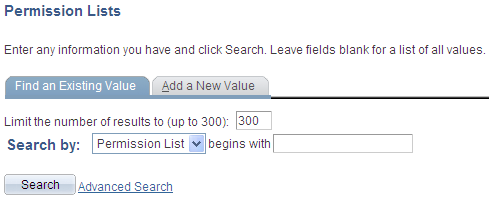
When you perform a search, you have some control over the number of items that the search retrieves. Although the maximum value and the default value are set by an administrator, you can enter a lower value in the Limit the number of results to field on the search page to further narrow your search results. If the search retrieves more than the maximum number of listings, the Search Results grid displays only the number of results requested in the Limit the number of results to setting. When the search criteria would otherwise yield a greater number of results than the limit, the actual total number of results appears in a message above the search results. You should narrow your search in another way if you cannot retrieve the data that you need on your first attempt.
Note: The default maximum value is set on the PeopleTools Options page.
Using Operators
When performing an advanced search, you can use a variety of operators to narrow your searches. For example, you can hunt for customers by a particular first letter, by values that are less than or greater than a specified amount, and so on. You can use the following operators:
|
Operator |
Field Use |
|---|---|
|
begins with |
Character fields. |
|
contains |
Character fields. |
|
= |
All field types. |
|
not= |
All field types. |
|
< |
All field types. |
|
<= |
All field types. |
|
> |
All field types. |
|
>= |
All field types. |
|
between |
All field types. |
|
in |
All field types. |
Note: If you use the in operator to search for multiple items, separated by commas, and you enter a space after the comma, the search automatically strips out that space. (For example, if you search for 1000, 1001, the search assumes that you are searching for 1000,1001. If you actually do want to search for a character string that contains a space, include that string within double quotes, like this: 1000," 1001".
You can use an operator for more than one field to make your search even more specific. For example, you could narrow your search for courses with the word orientation in the name by selecting the "=" operator for the Internal/External field and selecting Internal from the drop-down list box, as shown in the previous example. This search will find only courses that meet both criteria: internal courses that include the word orientation.
Saving Search Criteria
If you are conducting an advanced search, you can click the Save Search Criteria link to name and save the specifics of your search. If you have saved one or more searches, you can use the Use Saved Search drop-down list box to select a saved search. After you save a search, you can use that saved search in other search pages that use the same search record. You can remove any saved searches by clicking the Delete Saved Search link.
Image: Advanced Search page showing the PTools saved search
This example illustrates the Permission Lists Advanced Search page showing the PTools saved search.

Note: The applications stores saved searches by user ID.
PeopleSoft applications support three wildcard characters to help you search for data in character fields. You can use these wildcard characters to find the information that you need. The % and _ wildcard characters work in all autocomplete fields. On search pages and look up pages, wildcard characters only work with the begins with and contains operators.
Note: Certain applications support wildcard characters that are specific only to that application. See your application-specific product documentation for details.
The supported standard wildcard characters are:
|
Wildcard |
Search Action |
|---|---|
|
% (percent symbol) |
Match one or more characters. |
|
_ (underscore) |
Match any single character. |
|
\ (backslash) |
Escape character; do not treat the next character as a wildcard. |
For example, if you enter Q%admin as the User ID, then the system returns a list of user IDs that begin with Q and contain 'admin' as you can see in this example:
Image: Example of using wildcard characters on a search page
This example illustrates using wildcard characters on a search page.
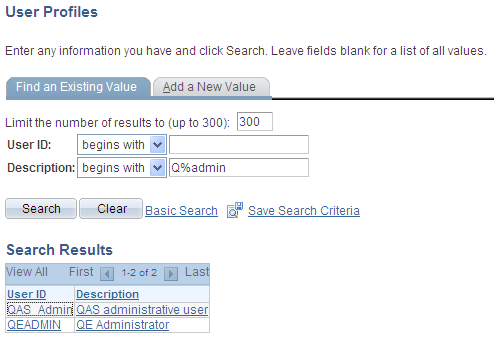
The presence of action mode fields on the search page indicate that the component uses PeopleSoft effective date logic.
Image: Search page showing the Include History and Correct History options
This example shows the Include History and Correct History options on a search page.
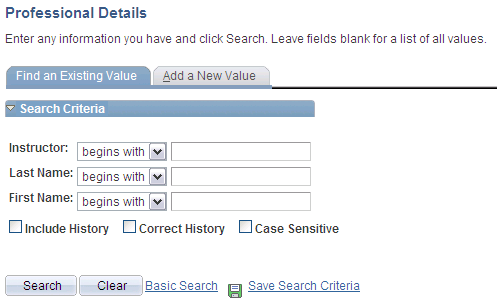
If you have the appropriate permissions for see and modify history records, then these two options can appear on a search page:
|
Field or Control |
Definition |
|---|---|
| Include History |
Select to retrieve history records when the system processes the search. |
| Correct History |
Select to retrieve and be able to correct history records when the system processes the search. |
Detailed information about PeopleSoft effective date logic is available in the next topic in this documentation.
Autocomplete (sometimes referred to as “type ahead”) provides a list of suggestions that match the data you enter in edit and prompt fields. Autocomplete lists can appear for two types of fields:
Edit fields on search pages.
Prompt fields.
Autocomplete fields support the use of the % and _ wildcard characters.
Edit Fields on Search Pages
When a search record field is autocomplete-enabled, as you type a letter into the field, and then pause, the autocomplete list appears and shows you values that match the letters you have entered to this point. The system returns the maximum number of allowed values, but it shows you a subset in the autocomplete window. An administrator sets the list limit, the list limit default is 50.
Image: Example autocomplete drop-down list showing user profiles that begin with the letters “Bene”
This example illustrates an autocomplete list on the User Profiles - Basic Search page.
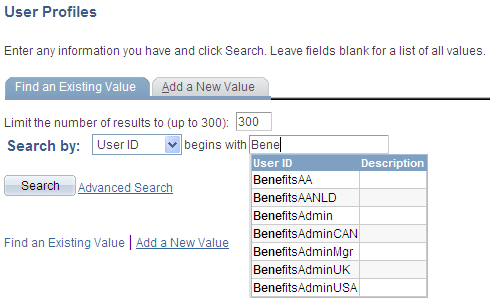
Prompt Fields
All prompt fields are autocomplete capable. When you enter data in a prompt field, the autocomplete results can vary slightly because you can configure the list to display up to five additional columns to assist in choosing the correct value.
Image: Example Role Name field autocomplete list showing role names that begin with the letter “B”
This example shows an autocomplete list for the Role Name field.

Image: Prompt field with autocomplete and wildcard characters
The following example illustrates autocomplete on a prompt field. Both the % and _ wildcard characters were used to generate this autocomplete list.
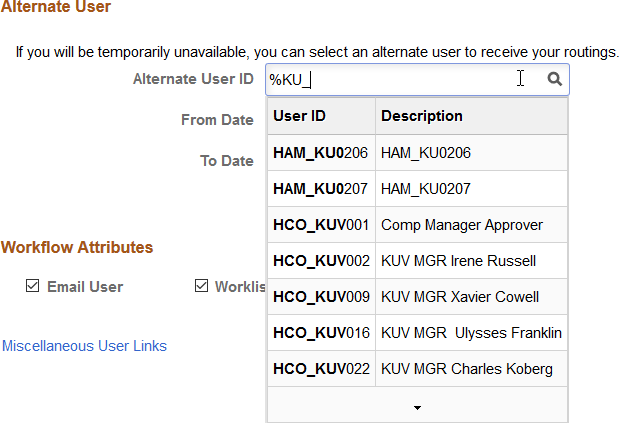
Important! Persistent search, the drop-down menu, and other forms of classic navigation are no longer supported. The default navigational interface for PeopleSoft applications in the current release is based on the fluid banner, which can be used for both classic and fluid applications. See Working with Fluid Pages and Controls.
You can configure PeopleSoft applications so that the results of your most recent search transactions are temporarily stored in the portal menu structure; these results are known as persistent or most recent search results.
Note these points about the accessibility and availability of persistent search results:
The most recent transaction search results for the currently active component appear in the navigation path next to the component name; this is visually indicated by the search icon.
The navigation path header retains your most recent transaction search results until another search is performed.
The most recent search for each of the five (5) most recently viewed components appears in the Favorites, Recent Search Results menu. The results are stored by menu item name, for example, User Profiles.
Only one search persists for any particular component: the most recently performed search.
Search results are retained only until your PeopleSoft session expires or until you sign out or close the browser.
This table shows the persistent search icon that can appear in the navigation path.
|
Field or Control |
Definition |
|---|---|
 |
Click to access the results of the most recent search that was performed in the currently active component. |
Accessing Search Results from the Navigation Path
To access the most recent search results for your current transaction page (component), click the persistent search icon in the navigation path. When you click the icon, the recent search results pop-up page appears, displaying a grid that contains the results of your last search. You can click the page header and drag the search results page to change its position within the browser window; however, the search results page retains focus until you:
Select an item.
To select another value from your recent search results, click any active link in the first column of the results grid.
Note: Only the values in the first column are active links to the transaction page. All other column values are text, not links.
Perform another search.
To perform another search that uses different criteria than the persistent search, click the Search Again link; this action returns you to the component search page.
Dismiss the search results page.
To dismiss the search results page, click the Close button in the upper left corner of the page header or press the Esc key.
Image: Example of Recent Search Results page as accessed from the navigation path for the Tree Manager component
In this example, you see the recent search results for the Tree Manager component. Notice the recent search icon in the navigation path.
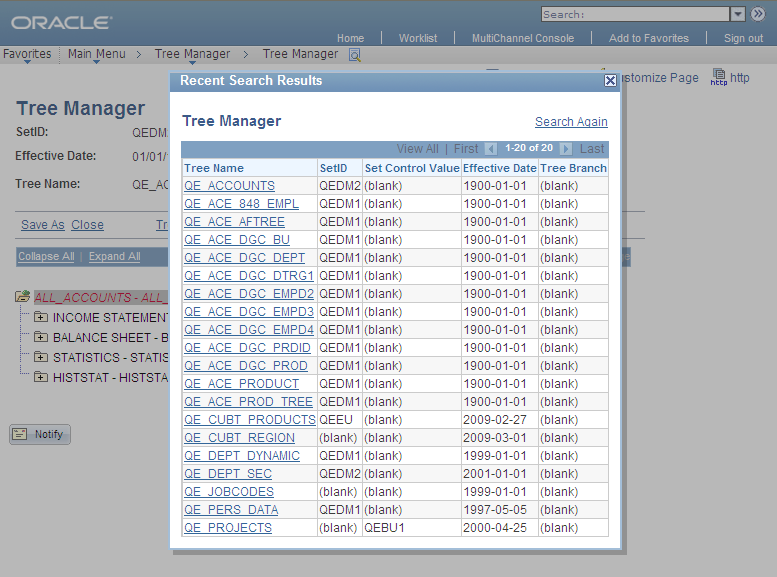
Accessing Search Results From the Recent Search Results Menu
To access the Recent Search Results menu, from the home page select Favorites and then click the Recent Search Results folder. Your search results cascade to the side.
Image: Example of Recent Search Results menu showing the most recent search for three components
This example shows the Recent Search Results folder and three recent component searches.

Click an item to retrieve the search results. When you select an item from the results, the application takes you to the component, retrieves the data, and updates the navigation path.